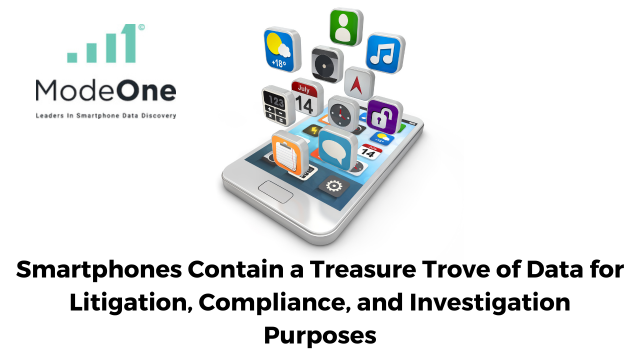
[EDRM Editor’s Note: EDRM is happy to amplify our Trusted Partners news and events. The opinions and positions are those of Ryan Frye and Greg Mazares.]
In today’s digital age, mobile devices have become an integral part of our business and personal lives, and they more and more play a crucial role in legal hold, corporate governance, and internal or government investigations. The data collected from these devices can serve as a treasure trove of relevant information, shedding light on critical aspects of a case. What types of data are generally collected from mobile devices, and why can such information be critical to successful outcomes of litigation matters, compliance initiatives, or investigations?
Call Logs: Following Phone Conversations
Call logs form a chronological record of incoming, outgoing, and missed calls on a mobile device. They offer crucial information about whom the custodian communicates with and how frequently. These records can establish connections between relevant individuals, uncover hidden relationships and identify additional custodians whose data should be collected. The communication patterns identified within call logs, such as frequent contacts or sudden spikes in activity, may offer valuable context for a case or investigation.
SMS has become the predominant mode of communication for mobile users, making it a vital collection source. Along with the text-based content, data such as emojis, images and stickers can reveal intentions, expose crucial information and provide a nuanced understanding of the interaction. Including SMS and other chat-type data in a data set greatly enhances the legal team’s discovery efforts.
Chat and Short Message Data: Glimpsing Brief Interactions
SMS messages and other chat-type data from popular messaging applications like WhatsApp, Signal, or Telegram offer a rich repository of critical information for eDiscovery. SMS has become the predominant mode of communication for mobile users, making it a vital collection source. Along with the text-based content, data such as emojis, images and stickers can reveal intentions, expose crucial information and provide a nuanced understanding of the interaction. Including SMS and other chat-type data in a data set greatly enhances the legal team’s discovery efforts.
Email: Eavesdropping on Communications
Emails remain a primary mode of communication in both personal and professional settings. They offer a comprehensive view of conversations, negotiations, and agreements and can help the legal team extract the story behind the case by establishing timelines, providing insight into decision-making processes, and uncovering communications between involved parties. While forensics experts will most often collect email data directly from a remote email server, it will only occasionally need to come from the mobile device. Simply, for the most part, email is not available for collection from mobile devices. Most devices restrict access to email without breaching security on the device. Email is synced to the phone from another location. If a smartphone is ever lost, reset, or stolen, data will therefore not be lost, as they are excluded from backup files and all other traditional access points targeted for collection.
GPS and Location Data: Tracking Movement
Mobile devices constantly self-track the many locations in which they have been, creating a valuable information resource for eDiscovery. GPS and location data can be used to determine a person’s movements, establish their presence or absence at specific locations, and corroborate or challenge witness testimonies. For instance, in a criminal investigation, location history can substantiate or disprove an alibi.
Photos, Videos and Audio: Scrutinizing Multimedia
Multimedia data captured and stored on mobile devices can serve as compelling evidence. Visual documentation of events, incidents, damage, or conversations can be instrumental in portraying the truth of a situation. Some communication platforms like Zoom or Meet allow participants to record virtual gatherings. These recordings, whether both audio and video or audio alone, provide defensible records of an interaction. It has also become common for people to record audio conversations where such data is admissible. We also heard from one industry expert who once collected over 100 hours of recordings from a judge who used Voice Memos/Recordings on his iPhone to memorialize all his trials!
Social Media Activity: Exploring Interchanges
Social media platforms have become an integral part of our lives, and such data can also provide valuable insights for eDiscovery. With that said, social media data is not collected directly from a mobile device (possibly except for some messages from Facebook Messenger). Much like SMS messages on texting apps, posts, comments, and messages on platforms like Facebook, Twitter, Instagram, and LinkedIn can offer a glimpse into a person’s thoughts, intentions, and interactions. This type of data can be especially relevant in defamation, harassment, or intellectual property disputes among others.
Internet Browsing History: Tracing Steps
Browsing history shows where the custodian has focused in the virtual world. It can provide valuable information about an individual’s interests, searches, plans and activities. Analyzing browsing habits and specific sites the device owner has visited can help build a comprehensive profile of that person and what he or she wants or intends to do. As such, it is often used in criminal matters to show that the defendant researched a crime before committing it.
App Data and Usage: Examining Programs
Mobile applications often store data related to their usage on the device. This information can be significant in various legal scenarios. For instance, app data may reveal financial transactions, health-related information, or behavior patterns. This data can be crucial in cases involving financial fraud and insurance claims.
Understand It, Collect It
Mobile device data can deliver a treasure trove of valuable information that can significantly impact the course and outcome of a litigation or investigation. Legal professionals must understand the data types available to develop efficient and trusted legal hold and data collection protocols. As technology evolves, the relevance of mobile device data in eDiscovery will continue to grow, making it a prominent aspect of modern legal practice.
Assisted by GAI and LLM Technologies per EDRM GAI and LLM Policy



